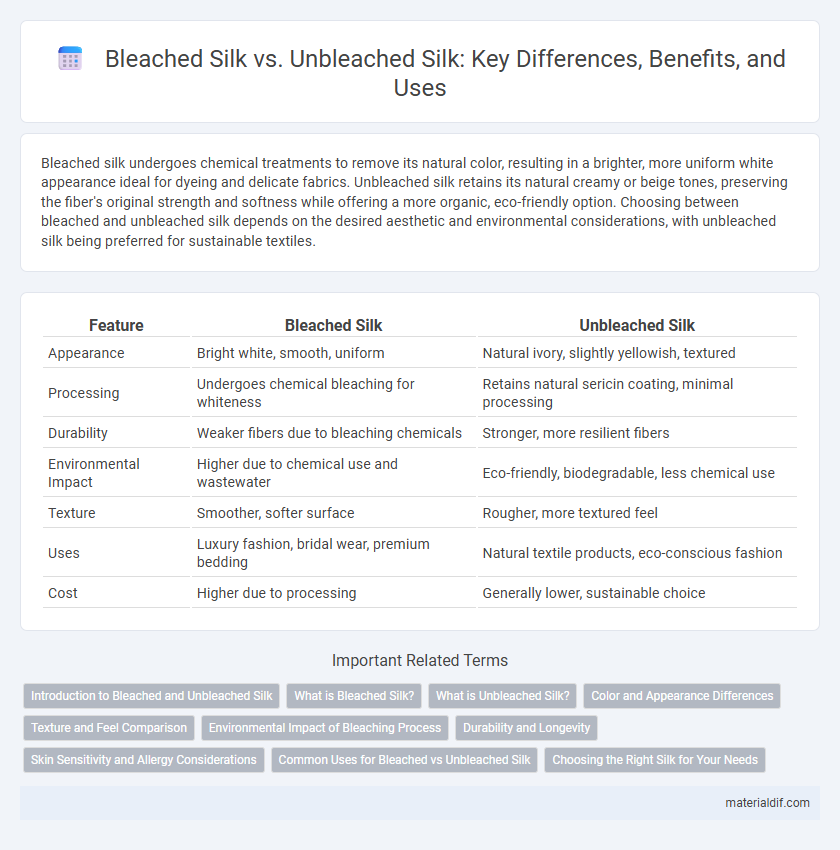Bleached silk undergoes chemical treatments to remove its natural color, resulting in a brighter, more uniform white appearance ideal for dyeing and delicate fabrics. Unbleached silk retains its natural creamy or beige tones, preserving the fiber's original strength and softness while offering a more organic, eco-friendly option. Choosing between bleached and unbleached silk depends on the desired aesthetic and environmental considerations, with unbleached silk being preferred for sustainable textiles.
Table of Comparison
| Feature | Bleached Silk | Unbleached Silk |
|---|---|---|
| Appearance | Bright white, smooth, uniform | Natural ivory, slightly yellowish, textured |
| Processing | Undergoes chemical bleaching for whiteness | Retains natural sericin coating, minimal processing |
| Durability | Weaker fibers due to bleaching chemicals | Stronger, more resilient fibers |
| Environmental Impact | Higher due to chemical use and wastewater | Eco-friendly, biodegradable, less chemical use |
| Texture | Smoother, softer surface | Rougher, more textured feel |
| Uses | Luxury fashion, bridal wear, premium bedding | Natural textile products, eco-conscious fashion |
| Cost | Higher due to processing | Generally lower, sustainable choice |
Introduction to Bleached and Unbleached Silk
Bleached silk undergoes a chemical process to remove its natural color, resulting in a brighter, pure white fabric ideal for dyeing and printing vibrant patterns. Unbleached silk retains its natural golden or ivory tones, preserving the raw, organic qualities favored in eco-friendly and artisanal textiles. Both types serve distinct purposes in fashion and interior design, with bleached silk offering a versatile canvas and unbleached silk providing a softer, more rustic aesthetic.
What is Bleached Silk?
Bleached silk undergoes a chemical process that removes its natural yellowish hue, resulting in a brighter, more uniform white fabric ideal for dyeing and printing. This treatment enhances the silk's purity and visual appeal without compromising its natural sheen and texture. Unlike unbleached silk, which retains its raw, earthy tones and slight imperfections, bleached silk offers a cleaner canvas for fashion and textile applications.
What is Unbleached Silk?
Unbleached silk is natural silk that retains its original color and texture without undergoing chemical bleaching processes, preserving its inherent strength and luster. Unlike bleached silk, which is whitened and sometimes weakened by harsh treatments, unbleached silk maintains its natural yellowish or off-white hue and offers enhanced durability. This type of silk is often favored for eco-friendly and organic textile products due to its minimal processing and chemical-free production.
Color and Appearance Differences
Bleached silk exhibits a bright white or ivory color due to chemical treatments that remove natural pigments, resulting in a smooth, glossy surface ideal for dyeing and printing. Unbleached silk retains its natural off-white or creamy beige tones, showcasing a more organic and raw appearance with subtle color variations and a matte finish. The bleaching process enhances silk's brightness and uniformity, while unbleached silk offers an authentic, rustic aesthetic favored for natural textile products.
Texture and Feel Comparison
Bleached silk features a smoother, more lustrous finish due to the removal of natural pigments, resulting in a lighter, softer texture that feels silkier against the skin. Unbleached silk retains its natural color and minor impurities, offering a slightly coarser, more textured feel with a matte appearance, reflecting its organic origin. The tactile differences impact applications where softness and sheen are prioritized versus those valuing authenticity and durability.
Environmental Impact of Bleaching Process
Bleached silk undergoes chemical treatments involving chlorine or hydrogen peroxide to remove natural color, which releases harmful pollutants and increases water contamination. Unbleached silk, retaining its natural hue, avoids these bleaching chemicals, resulting in a significantly lower environmental footprint. Choosing unbleached silk helps reduce toxic waste, conserves water, and supports more sustainable textile production.
Durability and Longevity
Bleached silk undergoes chemical treatment that can weaken its fibers, reducing durability compared to unbleached silk, which retains its natural strength and resilience. Unbleached silk offers greater longevity as it maintains the integrity of the protein structure, resisting damage from washing and wear more effectively. Choosing unbleached silk ensures a longer-lasting fabric with superior durability for garments and textiles.
Skin Sensitivity and Allergy Considerations
Bleached silk undergoes chemical treatments that can strip natural proteins, potentially increasing skin irritation and allergic reactions for sensitive individuals. Unbleached silk retains its natural sericin, which helps maintain skin hydration and reduces sensitivity risks. Choosing unbleached silk is often preferred for hypoallergenic benefits and minimizing dermatological concerns.
Common Uses for Bleached vs Unbleached Silk
Bleached silk is commonly used in high-end fashion, bridal gowns, and luxury bedding due to its bright, pure white appearance that easily accepts dyes and prints for vibrant colors. Unbleached silk retains its natural creamy tone, making it ideal for organic or eco-friendly products such as natural textiles, hand-dyed fabrics, and artisanal crafts that emphasize sustainability. Both types serve diverse markets, with bleached silk favored for polished, elegant finishes and unbleached silk preferred for authentic, rustic aesthetics.
Choosing the Right Silk for Your Needs
Bleached silk undergoes a whitening process that enhances brightness and is ideal for projects requiring a pure, vibrant appearance, while unbleached silk retains its natural, creamy color, offering a more organic and eco-friendly option. When choosing the right silk, consider the desired aesthetic and any sensitivity to chemicals, as bleached silk may involve harsher treatments affecting texture and durability. For sustainable fashion or delicate crafts, unbleached silk provides a softer, cleaner choice, whereas bleached silk suits bold designs demanding crisp, luminous fabric.
Bleached Silk vs Unbleached Silk Infographic

 materialdif.com
materialdif.com